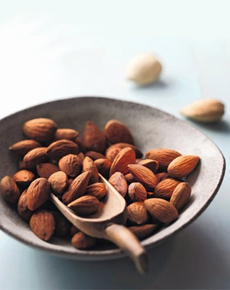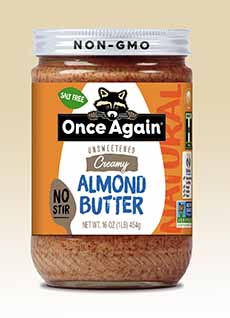
[1] We buy jumbo packages of raw almonds at Costco (photo © Niederegger Marzipan).

[2] These are green almonds, harvested from the tree before shelling and roasting. They get their name from the fuzzy green coat. They can be eaten whole, and taste crunchy and tart, with a hint at unripe peaches. When the green outer layer is removed, the young almonds are delicate, milky, and subtly floral and grassy (photo © Sid Wainer & Son).
|
|
February 16th is National Almond Day. Almonds are great for snacking, roasted or raw; and are so flavorful they don’t need added salt or salted seasonings.
Enjoy some almond trivia, then scroll down for a butter-enhanced recipe for Chinese Almond Cookies that also includes almond butter. For Americans, this is a delicious improvement on the traditional Chinatown recipe made with oil (which we also like, but trust us—these are better).
The recipe is below. But first:
ALMOND HISTORY & TRIVIA
Historians generally agree that almonds and dates, both mentioned in the Old Testament of the Bible, were among the earliest cultivated foods. The only other nut mentioned in the Bible (Genesis 43:11) is the pistachio nut.
Between 600 and 900 C.E., almond trees began to flourish in the Mediterranean, in Greece, Israel, Spain and Morocco. Because of their portability, explorers consumed them while traveling the Silk Road between the Mediterranean region and China.
Almonds are actually stone fruits related to cherries, plums and peaches. In this case, it’s the “stone” that is eaten. The botanical name of the almond tree is Prunus amygdalus.
California produces 80% of the world’s supply of almonds. The world’s largest almond factory is in Sacramento; it processes 2 million pounds of almonds a day. California produced 998 million pounds of almonds in 2004. The largest crop on record was in 2002: 1.084 billion pounds.
It takes more than 1.2 million beehives to pollinate California’s almond crop, which spans more than 550,000 acres.
Chocolate manufacturers use 40% of the almond crop (and 20% of the world’s peanuts).
It takes 1,000 pounds of almonds to make 1 pint of almond oil.
There are 5,639 people in the U.S. listed on Whitepages.com with the last name “Almond” (source: Mark Morton, “Gastronomica,” Fall 2010).
The Jordan almond, a large plump variety of almonds from Malaga, Spain, is considered to be the finest cultivated almond. It is frequently sold with a hard-colored sugar coating.
|
ALMOND NUTRITION
Almonds are the most nutrient-dense tree nut. One ounce of almonds (20-25 almonds) contains 160 calories and only 1 gram of saturated fat and no cholesterol. The unsaturated fat in almonds is “good” fat, with 13 grams per one-ounce serving.
Almonds are also an excellent source of vitamin E and magnesium, and a good source of protein and potassium.
Almonds are the highest in protein and fiber of all the tree nuts.
The protein in almonds is more like the proteins in the human breast milk of all the seeds and nuts, which is why it is the choice of the Canadian College of Naturopathic Medicine as the base for its baby formula.
Almonds are known for high satiety, almonds provide the perfect pre-workout boost, are easy to keep in your office drawer stash, for snacking alone or with yogurt or fruit.
|






